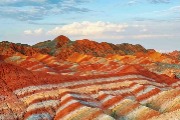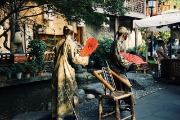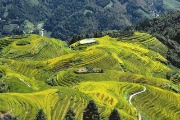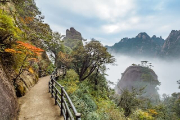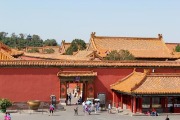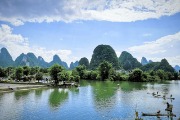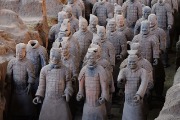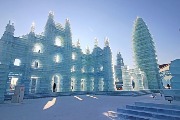Reed Flute Cave
It is a classic representation of the karst landscape in Guilin.
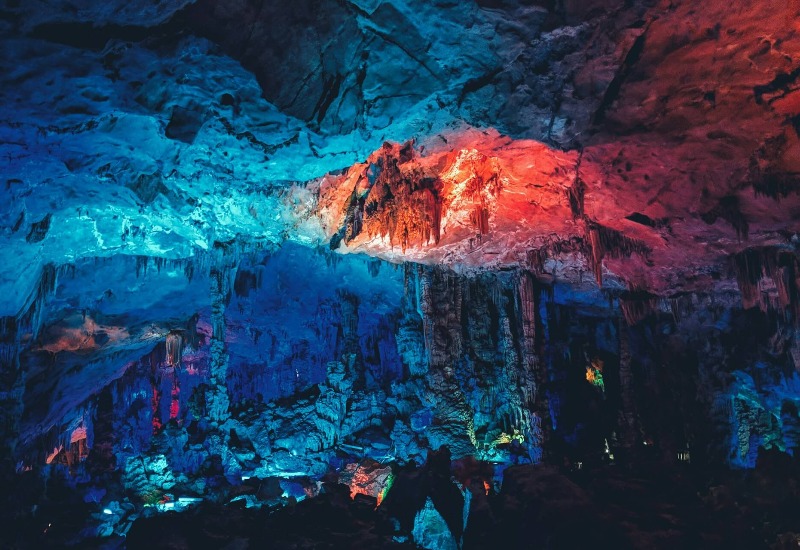
Guilin’s Reed Flute Cave (芦笛岩) is named after the reed grass that grows near its entrance. According to legend, this grass can be used to make flutes, and the music it produces is beautiful and soothing. That’s how the cave got its name—“Reed Flute Cave.”
The cave is a limestone formation that began taking shape around a million years ago. It was accidentally discovered by local villagers in 1959. After some expert exploration and development, it officially opened to the public in 1962.
Reed Flute Cave Guilin is also known as the “National Guest Cave” in China. Since 1962, it has welcomed over 45 million visitors from around the world, making it the most visited cave in the world. It has also hosted more than 300 heads of state and dignitaries, including leaders like Deng Xiaoping, Jiang Zemin, Hu Jintao, Richard Nixon, Jimmy Carter, Mikhail Gorbachev, and Prince Sihanouk of Cambodia.
We’ll take you on a tour to admire the stunning stalactite formations inside. If you’re a stalactite enthusiast, we’ll also recommend other nearby caves that are worth checking out. At the end, we’ll provide some FAQs and ticket information for Reed Flute Cave Guilin China.
Table of Contents
Highlights of China Reed Flute Cave

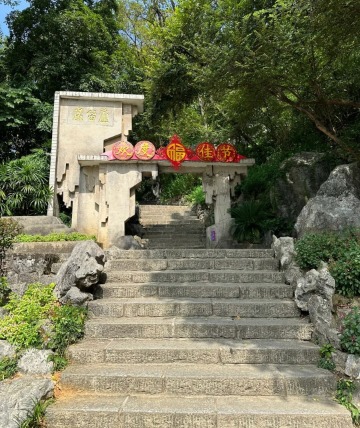
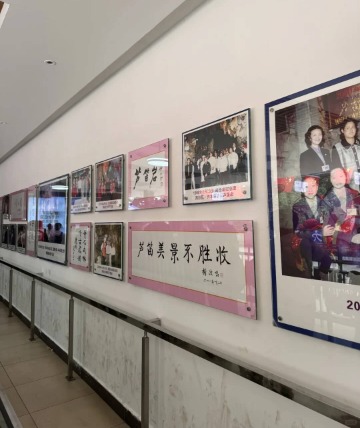
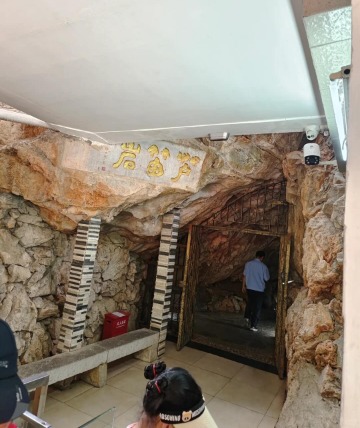
Entrance (入口)
The entrance to Reed Flute Cave is tucked away halfway up a mountain called “Bright Mountain.” It’s a 500-meter hike to get there. If you’d rather not climb, you can take a little train to the top, enjoy the scenic views along the way, and eventually reach the cave entrance. The train ticket costs around 30 CNY (about 4 USD), and the ride takes about 10 minutes. However, most visitors feel the train ride isn’t the best value. Once you reach the entrance, you can buy tickets on-site. Near the ticket booth, there’s a wall displaying photos of Chinese leaders and foreign dignitaries who’ve visited the cave.
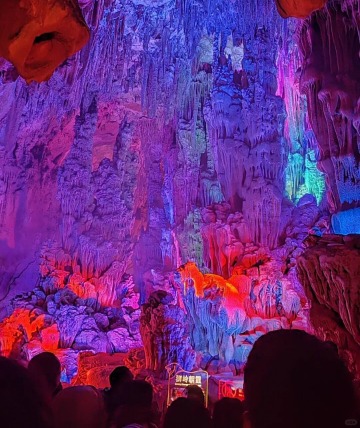
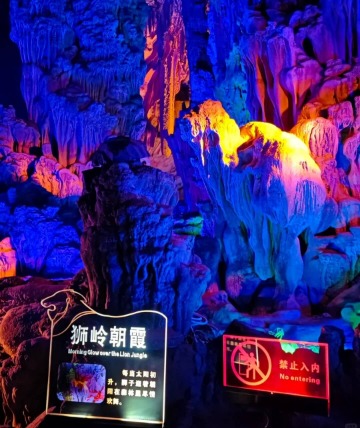
Lion Peak Morning Glow (狮岭朝霞)
Lion Peak Morning Glow is the most popular photo spot inside China Reed Flute Cave. The stalactites here look like a group of lions dancing in the forest at sunrise. One large lion is clearly visible, with its head, body, and tail all standing out. It seems to be guarding the smaller lions around it, giving the whole area a lively and energetic vibe.
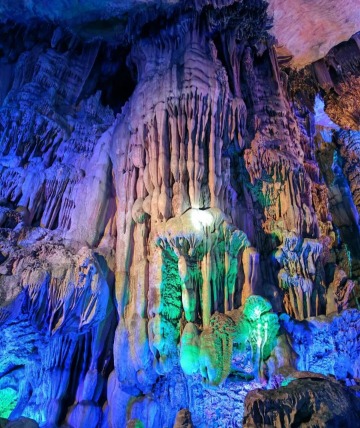
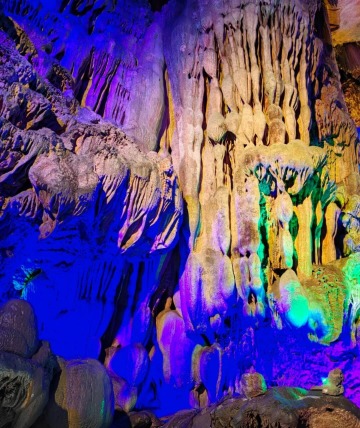
Bountiful Harvest of Melons and Vegetables (瓜菜丰收)
The Bountiful Harvest of Melons and Vegetables is another popular photo spot inside China Reed Flute Cave. The stalactites here take on all sorts of shapes—some look like beans, cucumbers, winter melons, radishes, and broccoli. They’re so lifelike, it feels like stepping into a picture of a bountiful harvest. Many visitors enjoy observing these formations and guessing which vegetable each one resembles.
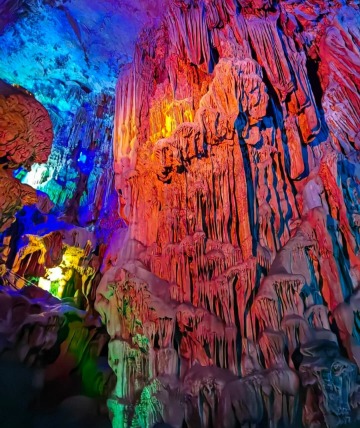
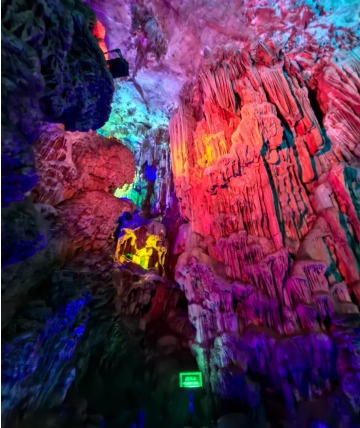
Mushroom Mountain (蘑菇山)
After “Melon and Vegetable Mountain,” you’ll find Mushroom Mountain. Looking around, you’ll see a lot of small “mushrooms” growing on the stone walls, with a few larger “mushrooms” at the bottom. If you look closely, you might even spot an “old man” picking mushrooms, walking down the mountain while collecting them (of course, this requires a bit of imagination!).
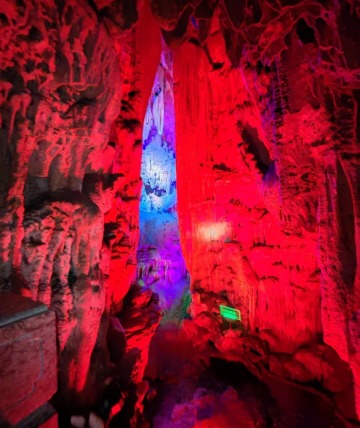
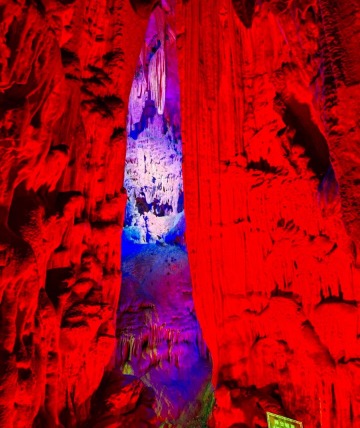
Stage Curtain (舞台帷幕)
As you move further inside, you’ll come across a spot that looks like a stage. The stalactites here resemble a curtain that’s just fallen after a performance. Sometimes, the tour guide will even sing a traditional Zhuang song, “Liu Sanjie,” for visitors right at this spot.
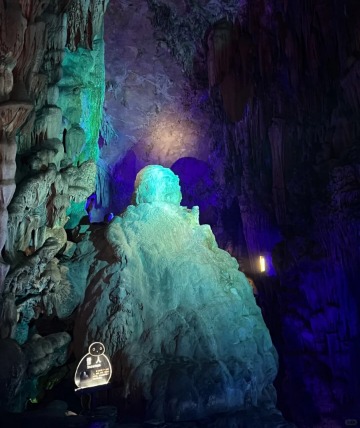
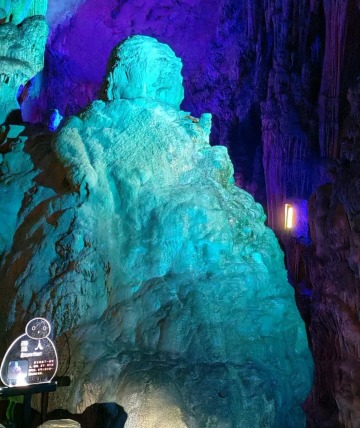
Snowman (雪人)
Inside Reed Flute Cave Guilin, there’s also a stalactite that looks like a snowman. It has a round, plump body and a circular head, with clear facial features, making it look almost identical to a real snowman. It seems to stand as a guard, protecting the cave.
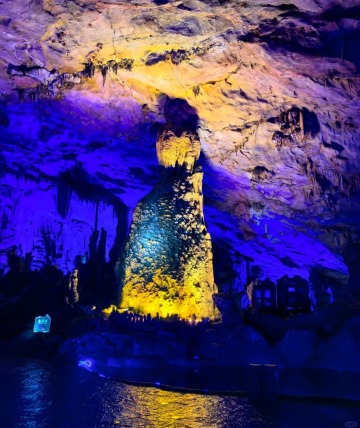

Fish Tail Peak (鱼尾峰)
Keep going, and you’ll see a giant fish tail, with layers of stalactites shaped like fish scales. Legend has it that this formation was created when a big carp got scared after seeing Sun Wukong causing chaos in the Dragon Palace. The carp tried to escape by squeezing into a small crack, but only its head could fit. Its body and tail were left outside, forming what we now call “Fish Tail Peak.”
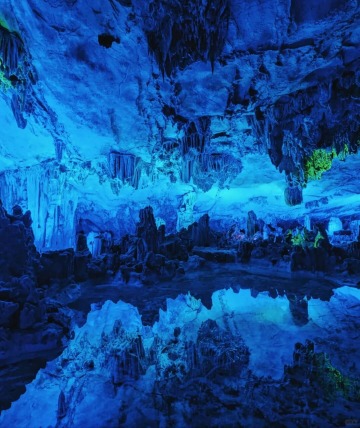
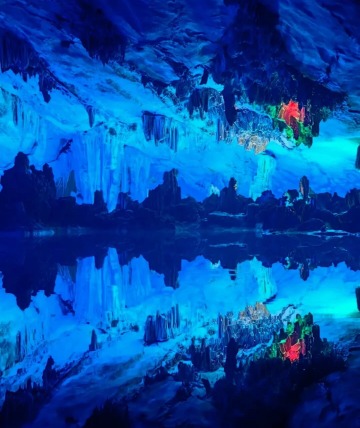
Crystal Palace (水晶宫)
The Crystal Palace is the largest area inside Reed Flute Cave Guilin China. The stalactites here sparkle like crystals under the lights. According to legend, this is where Sun Wukong caused his ruckus in the Heavenly Palace in Journey to the West. You’ll see vivid shapes of the Ruyi Jingu Bang (the magical staff), the big carp, jellyfish, and seashells, almost like stepping into a scene from Chinese mythology.
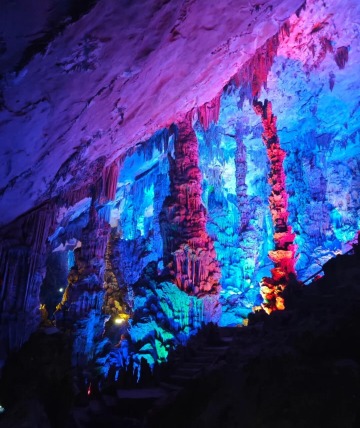
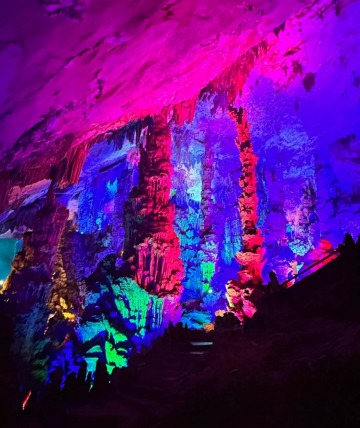
Primeval Forest (原始森林)
After the Crystal Palace, you’ll enter a stalactite landscape that feels like an “ancient forest.” The dense stone pillars stand tall, like ancient trees reaching up to the sky. It really gives you the feeling of being in a primeval world.
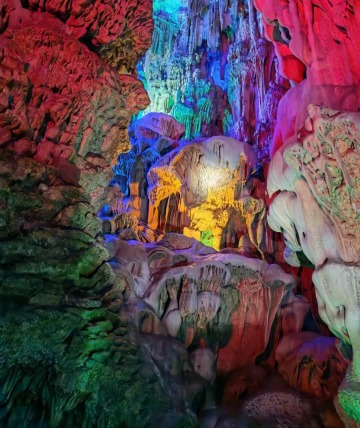
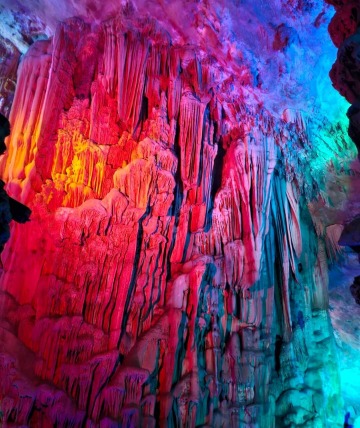
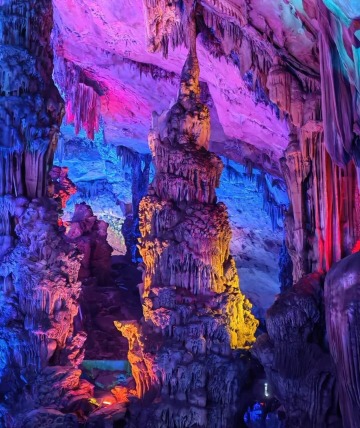
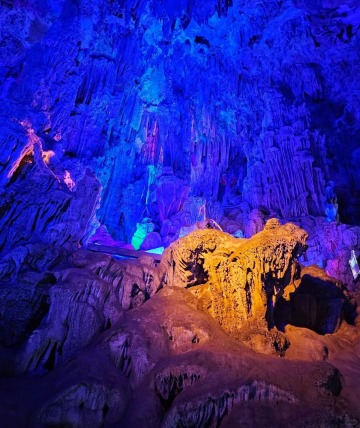
Other Stalactite Formations (其它钟乳石景观)
The spots mentioned above are just a small part of Reed Flute Cave Guilin. The entire tour covers about 500 meters, and every step reveals unique formations of stalagmites, stalactites, and stone columns. They create all sorts of scenes, like the Dragon Pagoda, the Underwater World, and the Flower and Fruit Mountain. Under the colorful lights, these formations are even more vibrant and striking.
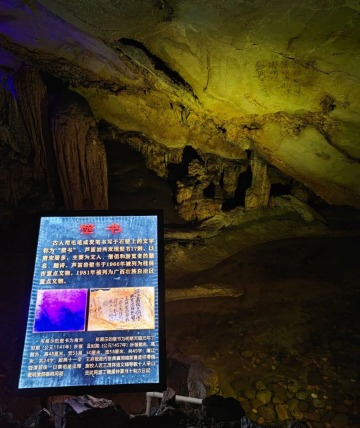
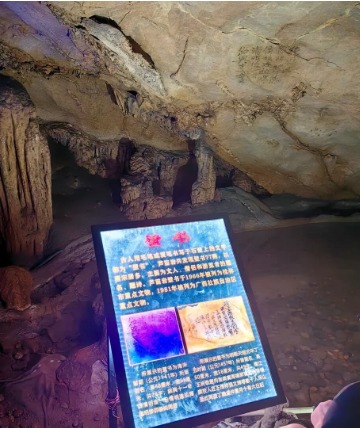
Wall Inscriptions (壁书)
Besides the stalactites, China Reed Flute Cave also has many wall inscriptions. Most of these were written by ordinary people from ancient China, recording natural disasters, man-made tragedies, and the hardships of life in the Guilin region over a thousand years ago.
Hiking through Guilin Reed Flute Cave
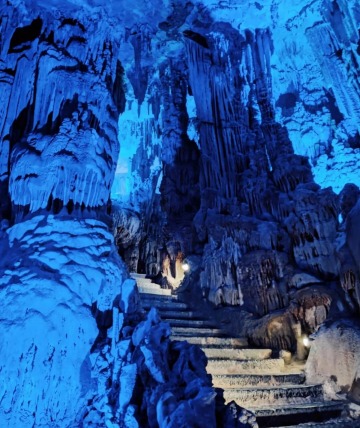
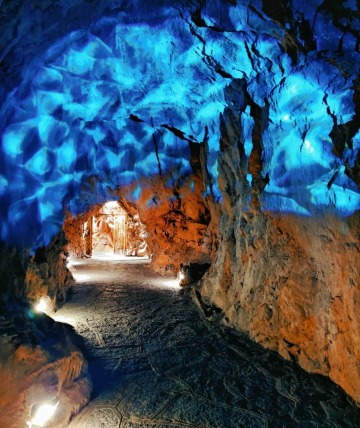
During the hike through Reed Flute Cave Guilin, you’ll have a free guide who will explain everything along the way, helping you understand the cave’s features and historical background. The temperature here stays around 20°C (68°F) year-round, so it’s always cool, almost like having a natural air conditioner. However, there are a lot of stairs, and the ground can be slippery, so it’s not ideal for strollers or wheelchairs.
Other Caves in Guilin
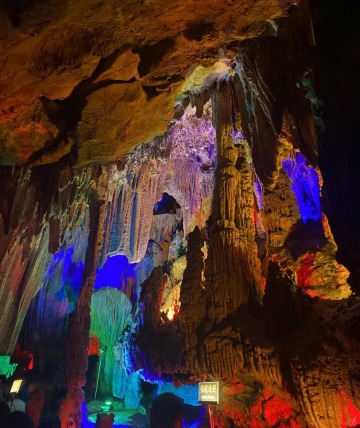
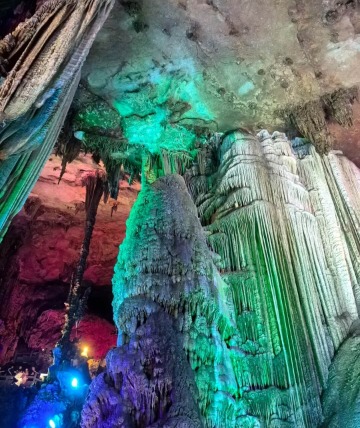
Silver Cave (Yinzi Cave) (银子岩)
Silver Cave is about a 30-minute drive from Yangshuo County in Guilin and 90 kilometers (about 56 miles) from Reed Flute Cave. Inside, the stalactites shimmer under the lights, giving off a silvery glow, which is how the cave got its name. Another version of the story is tied to the historical figure Wu Sangui. Legend has it that during the Qing Dynasty, one of Wu Sangui’s generals was stationed in Guilin. When the Qing army rebelled, the general couldn’t carry away all his gold and jewels, so he hid them in Silver Cave. Although countless treasure hunters have searched for it over the years, the saying “Visit Silver Cave, and you’ll never lack money” has survived. The tour path here is about 2 kilometers (about 1.24 miles) long, while Reed Flute Cave is only 500 meters (about 0.31 miles), making Silver Cave one of the most popular cave attractions in Guilin.
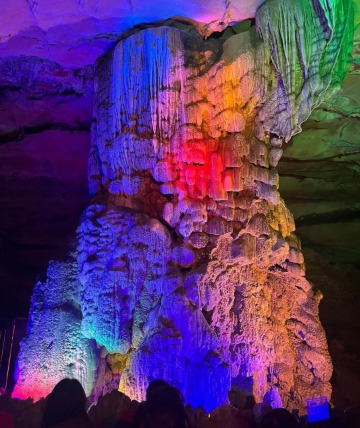

Seven Star Cave (Qixing Cave) (七星岩)
Seven Star Cave is about 10 kilometers (about 6 miles) from Reed Flute Cave Guilin China, located within Seven Star Park. The tour route inside is about 814 meters (about 0.5 miles) long. It was originally an ancient underground river, but after tectonic shifts, it became the cave formation you see today. In addition to the cave, there’s a temple where visitors can burn incense, and wild monkeys that you can feed.
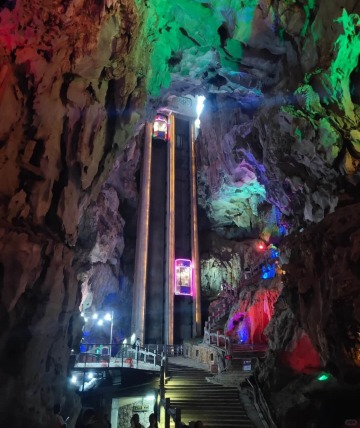
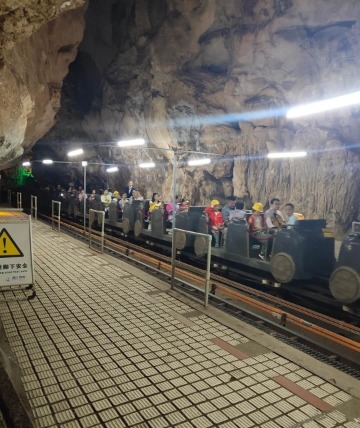
Crown Cave (Guan Cave) (冠岩)
Crown Cave is located in the Li River Scenic Area, about 45 kilometers (about 28 miles) from Reed Flute Cave. There are various ways to explore the cave, including hiking, taking a sightseeing elevator, or riding the small train inside the cave. Many visitors say this is the favorite cave for kids.
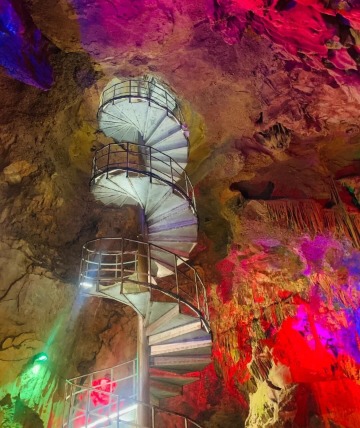
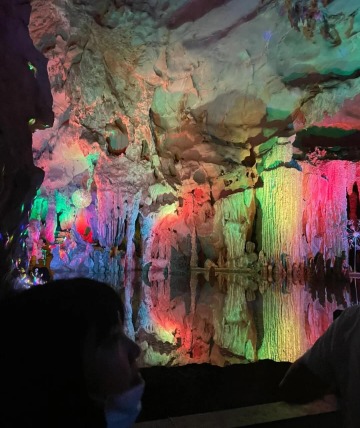
Golden Water Cave (Jinshui Cave) (金水岩)
Golden Water Cave is in Yangshuo County, about 90 kilometers (about 56 miles) from Reed Flute Cave. Besides the stalactite formations, you can also enjoy a mud bath and cave hot springs here. However, some visitors have reported poor guiding services and mandatory purchases, which affected their overall experience.
FAQs about Reed Flute Cave in Guilin
1. Why is the Reed Flute Cave so special and rare?
The answer is time. The stalactites you see in China Reed Flute Cave today took about a million years to form. This long period of time has made the cave’s formations richer and more spectacular than those in other places. Almost every step you take is like stepping through nature’s finest art.
2. How was Reed Flute Cave formed?
Over 300 million years ago, Guilin was covered by a vast ocean. Thick, pure carbonate deposits formed on the seabed, laying the foundation for the later karst landscape of Guilin. Around a million years ago, Reed Flute Cave was still an underground lake. Due to tectonic movements, the mountain gradually lifted, and the water table dropped, eventually turning the lake into a cave. Later, rainwater dissolved the calcium carbonate in the rocks, and these water droplets continued to fall from the ceiling. As the water fell, carbon dioxide escaped, and the calcium carbonate crystallized and settled. After hundreds of thousands of years, this process created the China Reed Flute Cave formations we see today.
3. Where is Reed Flute Cave?
Reed Flute Cave is located 6 kilometers (about 3.7 miles) from downtown Guilin, 100 kilometers (about 62 miles) from Yangshuo County, and about 70 kilometers (about 43 miles) from the Li River Scenic Area.
How to Get to Reed Flute Cave
From Guilin Liangjiang International Airport or Guilin South Railway Station:
You can take Bus No. 3, which goes directly to the entrance of the scenic area.
From downtown Guilin (Cross Street):
You can take Bus No. 213, which takes about 21 minutes and goes straight to Reed Cave China.
From Guilin Railway Station:
You can take Bus No. 3, which runs from 6:30 AM to 9:50 PM, with buses coming about every 10 minutes.
Hours & Fees
Hours
Daily from 7:30 AM to 6:00 PM
Time Required
1-2 hours
Fees
90 CNY (about 12 USD) per person
Practical Tips
It’s recommended to only buy tickets for the old scenic area. The new scenic area requires an extra ticket, but it mainly features man-made photo spots and projection displays, which aren’t as worth seeing.
If you’re taking a taxi, it’s better to set the destination to the second ticket office, near the China Reed Flute Cave police station. From there, it’s just a short walk to the cave entrance. If you set the destination to the parking lot ticket office, you’ll need to climb a set of stairs.
The small train inside the scenic area costs 30 CNY (about 4 USD) per person. In reality, it’s only a 10-minute walk, so it’s not really necessary to pay for it. However, if you don’t feel like walking, you can give it a try.

